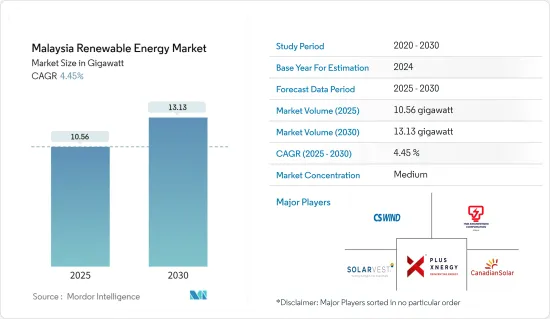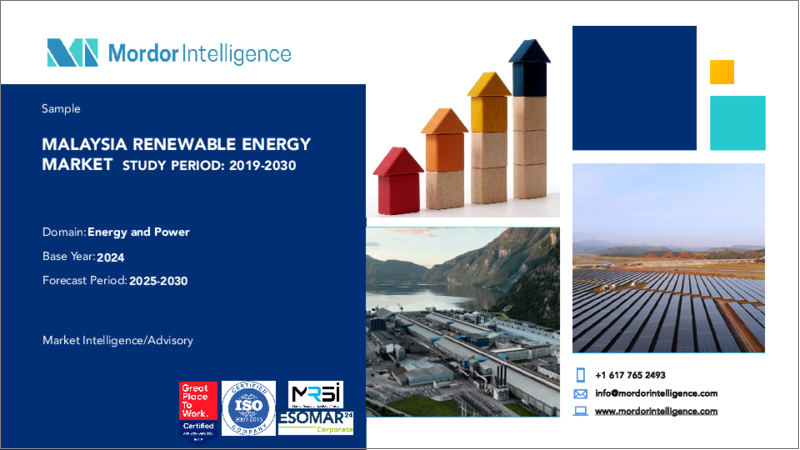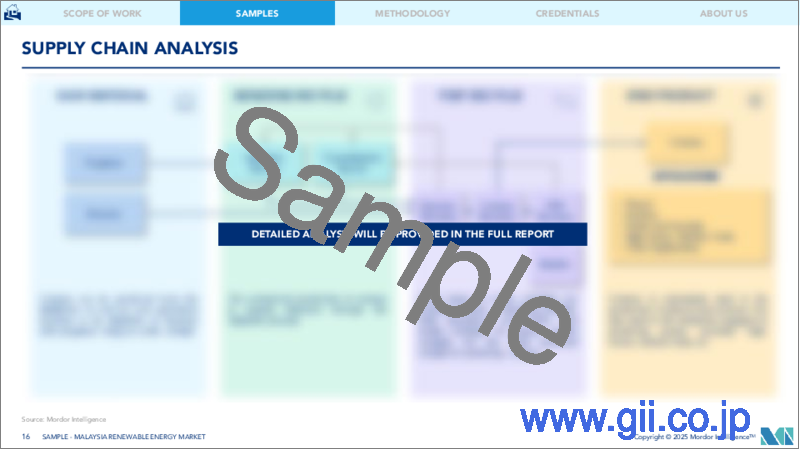|
|
市場調査レポート
商品コード
1640455
マレーシアの再生可能エネルギー:市場シェア分析、産業動向と統計、成長予測(2025年~2030年)Malaysia Renewable Energy - Market Share Analysis, Industry Trends & Statistics, Growth Forecasts (2025 - 2030) |
||||||
カスタマイズ可能
適宜更新あり
|
|||||||
| マレーシアの再生可能エネルギー:市場シェア分析、産業動向と統計、成長予測(2025年~2030年) |
|
出版日: 2025年01月05日
発行: Mordor Intelligence
ページ情報: 英文 95 Pages
納期: 2~3営業日
|
全表示
- 概要
- 目次
マレーシアの再生可能エネルギー市場規模は2025年に10.56ギガワットと推定され、2030年には13.13ギガワットに達すると予測され、予測期間(2025~2030年)のCAGRは4.45%です。

COVID-19の蔓延により、投資が減少し、閉鎖を余儀なくされた地域もあったため、市場は打撃を受けました。
主要ハイライト
- 本予測の対象期間中、市場は、投資の増加や、化石燃料から再生可能エネルギーへの電力源の転換に向けたマレーシア政府の取り組みなどによって牽引されるとみられます。
- しかしその一方で、ガス火力発電所や原子力プロジェクトといったクリーンな代替電源の採用が増加していることなどが、調査期間中の市場成長の妨げになる可能性が高いです。
- マレーシアは、2050年までに9GWの太陽エネルギー容量を導入することを目指しています。そのため、同国の野心的な太陽エネルギー目標やソーラーリースなどのビジネスモデルは、近い将来に大きなビジネス機会を生み出すと期待されています。
マレーシアの再生可能エネルギー市場動向
市場を独占する太陽光発電(PV)
- 太陽光発電がマレーシアの再生可能エネルギー市場を席巻するのは、いくつかの重要な要因による。まず第一に、マレーシアは赤道近くに位置し、年間を通じて日照量が多いため、豊富な太陽資源に恵まれています。この自然の優位性は太陽光発電設備にとって強力な基盤となり、再生可能エネルギーの選択肢として非常に現実的なものとなっています。太陽光発電技術のコスト低下は、そのコスト競合を著しく向上させ、投資家やエネルギー消費者にとってますます魅力的なものとなっています。
- マレーシア政府は、太陽光発電開発を促進するための支援施策やインセンティブを実施しています。ネットエネルギーメータリング(NEM)のような制度により、消費者は太陽光発電システムを設置し、余剰電力を送電網に売ることができます。同時に、固定価格買取制度や税制優遇措置により、太陽光発電プロジェクトへの投資が奨励されています。
- 例えば、2022年10月、マレーシア政府は第4次LSS4入札における大規模太陽光発電(PV)プロジェクトの売電契約期間の延長を決定しました。当初の21年から25年に延長されました。LSS4プログラムでは、30のプロジェクトで合計823.06MWの容量割り当てに成功しました。LSS4プログラム全体では、2,457MWの発電容量が割り当てられたが、2022年6月現在、稼働しているのは1,160MWのみです。
- 技術の進歩も太陽光発電の隆盛に重要な役割を果たしています。産業はソーラーパネルの効率と全体的な性能の大幅な向上を目の当たりにし、コスト削減と発電能力の向上を推進してきました。
- 国際再生可能エネルギー機関(International Renewable Energy Agency)によると、同国の太陽光発電設備容量は2021~2022年にかけて8%以上増加し、太陽光発電の採用が増加していることを示しています。
- したがって、上記の要因から、予測期間中、公益事業部門がマレーシアの再生可能エネルギー市場を独占すると予想されます。
市場を牽引する政府の支援施策
- マレーシアの再生可能エネルギー市場を牽引する上で、政府の施策は極めて重要な役割を果たしています。政府は、再生可能エネルギーの成長を刺激するために、固定価格買取制度の確立や、再生可能エネルギー生産者に安定した長期契約を提供する電力購入契約など、様々な施策措置を実施しており、このセグメントへの投資を促進しています。野心的な再生可能エネルギー目標を設定することは、投資家にとって明確な方向性を示し、市場に参加するインセンティブとなります。
- マレーシアは、2025年までにエネルギーの20%を再生可能エネルギーで賄うという目標を掲げています。この目標を達成するためには、再生可能エネルギー部門に約80億米ドルの投資が必要となります。予想される投資は、政府資金、官民パートナーシップ、民間融資の組み合わせによるものと予想されます。
- 政府は、民間融資を奨励し、再生可能エネルギー部門への民間参入を強化する意向です。グリーン技術融資制度、グリーン投資税制、グリーン所得税免除など、現在行われている政府の優遇措置に加え、再生可能エネルギーのさらなる成長を支える制度改革の実施に重点が置かれます。
- 国際再生可能エネルギー機関によると、国内の再生可能エネルギーの設備容量は2018~2022年にかけて大幅に増加しました。この間の成長率は20%以上を記録しており、この地域における再生可能エネルギーの健全な成長を示しています。
- 合理化された許認可プロセスを伴う支援的な規制の枠組みも、開発者にとっての障壁や官僚的なハードルを減らし、再生可能エネルギープロジェクトの開発を促進しています。
- 例えば、2023年3月、マレーシアのサバ州ラブアンにある10MWACソーラープロジェクトは、Solar PV Power Sdn Bhd(SPP)を通じてファイナンシャル・クローズを達成しました。SPPはJetama Energy Sdn Bhd(Jetama)とSymbior Solar Limited(Symbior)の合弁会社です。
- そのため、政府の支援施策やイニシアティブが、ソーラー・再生可能エネルギーのシェアを押し上げると予想されます。
マレーシアの再生可能エネルギー産業概要
マレーシアの再生可能エネルギー市場は適度にセグメント化されています。同市場の主要企業(順不同)には、JA Solar Technology、Solarvest Holdings Berhad、TNB Engineering Corporation Sdn Bhd、CS Wind Malaysia、Plus Xnergy Holding Sdn Bhdなどがあります。
その他の特典
- エクセル形式の市場予測(ME)シート
- 3ヶ月間のアナリストサポート
目次
第1章 イントロダクション
- 調査範囲
- 市場の定義
- 調査の前提
第2章 調査手法
第3章 エグゼクティブサマリー
第4章 市場概要
- イントロダクション
- 再生可能エネルギーミックス(マレーシア、2022年)
- 再生可能エネルギー設備容量と2028年までの予測(単位:MW)
- 政府の規制と施策
- 最近の動向と開発
- 市場力学
- 促進要因
- 政府の支援施策とインセンティブ
- 再生可能エネルギープロジェクトへの投資の増加
- 抑制要因
- グリッド統合の課題
- 促進要因
- サプライチェーン分析
- PESTLE分析
第5章 市場セグメンテーション:タイプ別
- 太陽光
- 水力
- バイオエネルギー
- その他
第6章 競合情勢
- M&A、合弁事業、提携、協定
- 主要企業の戦略
- 企業プロファイル
- First Solar Inc.
- Canadian Solar Inc.
- Plus Xnergy Holding Sdn Bhd
- TNB Engineering Corporation Sdn Bhd
- Solarvest Holdings Berhad
- JA SOLAR Technology Co. Ltd
- SunPower Corporation
- Trina Solar Co. Ltd
- CS Wind Malaysia
- TS Solartech Sdn Bhd
第7章 市場機会と今後の動向
- 様々なセクターにおけるエネルギー効率の改善
The Malaysia Renewable Energy Market size is estimated at 10.56 gigawatt in 2025, and is expected to reach 13.13 gigawatt by 2030, at a CAGR of 4.45% during the forecast period (2025-2030).

The spread of COVID-19 hurt the market because investments dropped and some regions had to close down.Currently, the market has rebounded from pre-pandemic levels.
Key Highlights
- During the period covered by the forecast, the market is likely to be driven by things like more investments and the country's efforts to switch from fossil fuels to renewable energy as a source of power.The government of Malaysia has also put in place policies and incentives to help solar energy grow, which is expected to drive the market even more.
- However, on the other hand, factors such as the rising adoption of alternate clean power sources, such as gas-fired power plants and nuclear energy projects, are likely to hinder the market's growth during the study period.
- Malaysia is aiming to install 9 GW of solar energy capacity by 2050. Therefore, the country's ambitious solar energy targets and business models such as solar leasing are expected to create significant opportunities in the near future.
Malaysia Renewable Energy Market Trends
Solar Photovoltaic (PV) to Dominate the Market
- Solar PV is poised to dominate the renewable energy landscape in Malaysia due to several key factors. First and foremost, Malaysia enjoys abundant solar resources due to its location near the equator and high levels of sunlight throughout the year. This natural advantage provides a strong foundation for solar PV installations, making it a highly viable renewable energy option. The declining costs of solar PV technology have significantly improved its cost competitiveness, making it increasingly attractive for investors and energy consumers.
- The Malaysian government has implemented supportive policies and incentives to foster solar energy development. Programs like Net Energy Metering (NEM) allow consumers to install solar PV systems and sell excess electricity back to the grid. At the same time, feed-in tariffs and tax incentives encourage investment in solar PV projects.
- For instance, in October 2022, the Malaysian government decided to extend the duration of power purchase agreements for large-scale photovoltaic (PV) projects under the fourth LSS4 tender. The original period of 21 years was increased to 25 years. The LSS4 program successfully allocated a total capacity of 823.06 MW across 30 projects. Overall, the program has awarded 2,457 MW of capacity, but as of June 2022, only 1,160 MW of that capacity was operational.
- Technological advancements have also played a crucial role in the prominence of solar PV. The industry has witnessed significant improvements in solar panel efficiency and overall performance, driving down costs and enhancing power generation capabilities.
- According to the International Renewable Energy Agency, the installed capacity of solar photovoltaics in the country increased by more than 8% between 2021 and 2022, signifying the increasing adoption of solar photovoltaics in the country.
- Therefore, based on the factors above, the utility sector is expected to dominate the Malaysian renewable energy market during the forecast period.
Supportive Government Policies to Drive the Market
- Government policies play a pivotal role in driving the renewable energy market in Malaysia. The government has implemented various policy measures to stimulate the growth of renewable energy, including the establishment of feed-in tariffs and power purchase agreements that provide stable and long-term contracts for renewable energy producers, encouraging investment in the sector. Setting ambitious renewable energy targets provides a clear direction and incentive for investors to participate in the market.
- Malaysia has set a target to derive 20% of its energy from renewable sources by 2025. The country will require an investment of approximately USD 8 billion in its renewable energy sector to achieve this goal. The expected investments are anticipated to come from a combination of government funding, public-private partnerships, and private financing.
- The government intends to encourage private financing and enhance private participation in the renewable energy sector. In addition to the ongoing government incentives like the Green Technology Financing Scheme, the Green Investment Tax Allowance, and the Green Income Tax Exemption, the emphasis will be on implementing institutional reforms to support the growth of renewable energy further.
- According to the International Renewable Energy Agency, the installed capacity of renewable energy in the country increased significantly between 2018 and 2022. The growth rate during this period was recorded at more than 20%, signifying healthy growth of renewables in the region.
- A supportive regulatory framework with streamlined permitting processes has also reduced barriers and bureaucratic hurdles for developers, facilitating the development of renewable energy projects.
- For instance, in March 2023, the 10 MWAC Solar Project in Labuan, Sabah, Malaysia, achieved financial close through Solar PV Power Sdn Bhd (SPP). SPP is a joint venture between Jetama Energy Sdn Bhd (Jetama) and Symbior Solar Limited (Symbior).
- Therefore, supportive government policies and initiatives are expected to drive the share of solar and renewable energy.
Malaysia Renewable Energy Industry Overview
The Malaysian renewable energy market is moderately fragmented. Some of the major players in the market (in no particular order) include JA Solar Technology Co. Ltd, Solarvest Holdings Berhad, TNB Engineering Corporation Sdn Bhd, CS Wind Malaysia, and Plus Xnergy Holding Sdn Bhd.
Additional Benefits:
- The market estimate (ME) sheet in Excel format
- 3 months of analyst support
TABLE OF CONTENTS
1 INTRODUCTION
- 1.1 Scope of the Study
- 1.2 Market Definition
- 1.3 Study Assumptions
2 RESEARCH METHODOLOGY
3 EXECUTIVE SUMMARY
4 MARKET OVERVIEW
- 4.1 Introduction
- 4.2 Renewable Energy Mix, Malaysia, 2022
- 4.3 Renewable Energy Installed Capacity and Forecast in MW, till 2028
- 4.4 Government Policies and Regulations
- 4.5 Recent Trends and Developments
- 4.6 Market Dynamics
- 4.6.1 Drivers
- 4.6.1.1 Supportive Government Policies and Incentives
- 4.6.1.2 Increasing Investments in Renewable Energy Projects
- 4.6.2 Restraints
- 4.6.2.1 Grid Integration Challenges
- 4.6.1 Drivers
- 4.7 Supply Chain Analysis
- 4.8 PESTLE Analysis
5 MARKET SEGMENTATION - BY TYPE
- 5.1 Solar
- 5.2 Hydro
- 5.3 Bio-energy
- 5.4 Other types
6 COMPETITIVE LANDSCAPE
- 6.1 Mergers and Acquisitions, Joint Ventures, Collaborations, and Agreements
- 6.2 Strategies Adopted by Leading Players
- 6.3 Company Profiles
- 6.3.1 First Solar Inc.
- 6.3.2 Canadian Solar Inc.
- 6.3.3 Plus Xnergy Holding Sdn Bhd
- 6.3.4 TNB Engineering Corporation Sdn Bhd
- 6.3.5 Solarvest Holdings Berhad
- 6.3.6 JA SOLAR Technology Co. Ltd
- 6.3.7 SunPower Corporation
- 6.3.8 Trina Solar Co. Ltd
- 6.3.9 CS Wind Malaysia
- 6.3.10 TS Solartech Sdn Bhd
7 MARKET OPPORTUNITIES AND FUTURE TRENDS
- 7.1 Improving Energy Efficiency Across Various Sectors






